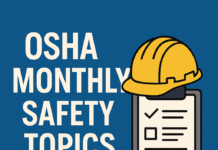
OSHA Requirements for Employers: Ensuring Workplace Safety
Introduction
OSHA Requirements for Employers : In today’s dynamic and ever-evolving workplace landscape, the safety and well-being of employees are paramount. To achieve this, employers must adhere to strict regulations set forth by the Occupational Safety and Health Administration (OSHA). This comprehensive guide will delve into the OSHA requirements for employers, helping them understand their responsibilities and ensure a safe working environment for their staff.
Understanding OSHA
Before we delve into the specific requirements, let’s have a closer look at what OSHA is and why it matters.
What is OSHA?
The Occupational Safety and Health Administration (OSHA) is a federal agency within the United States Department of Labor. Its primary mission is to ensure safe and healthy working conditions for employees by enforcing standards and regulations.
Employee Rights and Responsibilities
To promote workplace safety, OSHA outlines certain rights and responsibilities for both employers and employees.
Employee Rights
- Right to a Safe Workplace: Employees have the right to work in an environment that is free from recognized hazards that could cause serious harm or death.
- Access to Information: Employees must be informed about hazardous materials present in their workplace and provided with access to relevant safety data sheets (SDS).
- Protection from Retaliation: Employees have the right to report workplace hazards without fear of retaliation.
Employee Responsibilities
- Compliance: Employees must follow all safety and health regulations and standards set by their employer and OSHA.
- Reporting Hazards: If an employee identifies a hazard, they must report it promptly to their supervisor or employer.
Employer Requirements
Now, let’s dive into the specific requirements that employers must meet to ensure workplace safety.
Written Safety and Health Program
- Develop a Written Program: Employers must create and maintain a written safety and health program that outlines the steps and procedures for addressing workplace hazards.
- Employee Training: Ensure that employees are trained on the safety program and understand their responsibilities.
Hazard Communication
- Hazard Identification: Identify and label hazardous chemicals in the workplace.
- Safety Data Sheets (SDS): Maintain SDS for hazardous chemicals and ensure that employees have access to them.
Emergency Action Plans
- Emergency Procedures: Establish and communicate emergency action plans, including evacuation procedures and contacts.
- Fire Prevention: Implement fire prevention measures and provide proper firefighting equipment.
Personal Protective Equipment (PPE)
- PPE Assessment: Assess the workplace for potential hazards requiring PPE.
- Provide PPE: Supply appropriate PPE to employees and ensure its proper use.
Recordkeeping and Reporting
- Injury and Illness Records: Maintain records of all workplace injuries and illnesses as per OSHA’s requirements.
- Report to OSHA: Report all severe injuries, hospitalizations, and fatalities to OSHA within specified timeframes.
Conclusion
Ensuring compliance with OSHA requirements is not just a legal obligation; it is a moral imperative. Employers have a responsibility to protect their employees from harm and create a safe and healthy work environment.
By following the guidelines and requirements outlined by OSHA, employers can significantly reduce workplace accidents and injuries, fostering a culture of safety within their organizations.
Occupational Safety and Health Regulations in the USA
Which is Better: NEBOSH, IOSH, or OSHA?
OSHA 30-Hour Construction Certification
OSHA 10-Hour Construction Certification
OSHA 10-Hour General Industry Certification
FAQs
1. What is the purpose of OSHA?
OSHA’s primary purpose is to ensure safe and healthy working conditions for employees by enforcing safety and health standards and regulations.
2. Are all employers subject to OSHA regulations?
In general, yes. OSHA regulations apply to most private sector employers in the United States.
3. How can employers stay updated on OSHA regulations?
Employers can stay informed about OSHA regulations through OSHA’s official website, training programs, and industry-specific resources.
4. What happens if an employer fails to comply with OSHA regulations?
Non-compliance with OSHA regulations can lead to penalties, fines, and legal consequences for employers.
5. Can employees refuse to work in an unsafe environment?
Yes, employees have the right to refuse work if they believe it poses an imminent danger to their health or safety. However, they should follow specific procedures for reporting such concerns to their employer and OSHA.
























